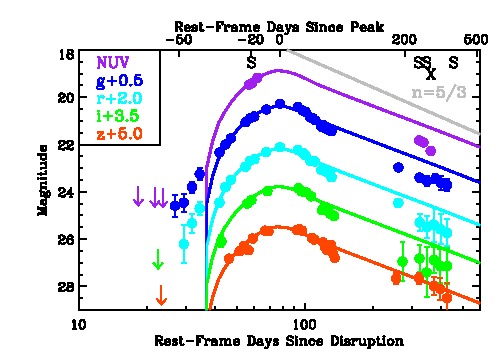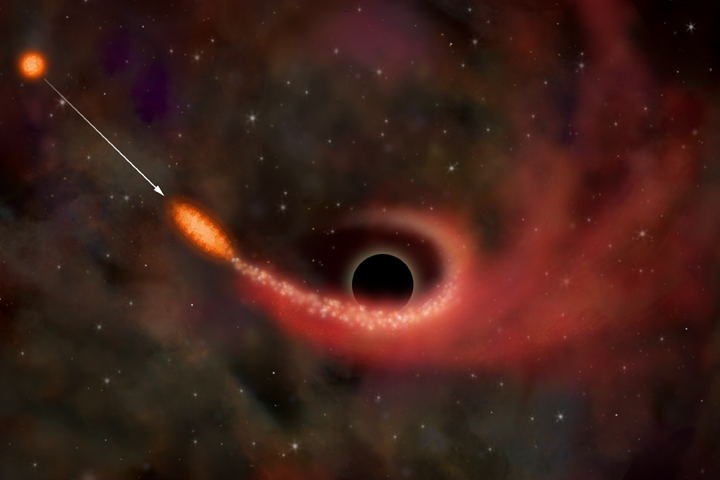- Title: An ultraviolet-optical flare from the tidal disruption of a helium rich stellar core
- Authors: S. Gezari, R. Chornock, A. Rest, M. E. Huber, K. Forster, E. Berger, P. J. Challis, J. D. Neill, D. C. Martin, T. Heckman, A. Lawrence, C. Norman, G. Narayan, R. J. Foley, G. H. Marion, D. Scolnic, L. Chomiuk, A. Soderberg, K. Smith, R. P. Kirshner, A. G. Riess, S. J. Smartt, C.W. Stubbs, J.L. Tonry, W. M. Wood-Vasey, W. S. Burgett, K. C. Chambers, T. Grav, J. N. Heasley, N. Kaiser, R.-P. Kudritzki, E. A. Magnier, J. S. Morgan, P. A. Price
- First Author’s Institution: Department of Physics and Astronomy, Johns Hopkins University
The Nature letter that I will be summarizing today reports on the very exciting discovery of a bright flare of radiation in the inactive nucleus of a galaxy at redshift z= 0.17. The authors argue that such UV-optical flash is caused by the tidal disruption and accretion of a star onto a supermassive black hole. Because we can watch this dramatic event from 2.7 billion light years ago unfold, it feels a bit like sitting at the cinema and watching a crime scene.
Supermassive black holes reside at the centers of virtually every galaxy. These guys have masses between a million and a billion times that of the Sun, and swallow anything they manage to find in the vicinity (See this recent astrobite on the munching habits of the black hole in our own Galaxy). If the process of accretion onto these black holes involves gas, then lots of radiation is observed, and we can therefore infer the presence of a greedy black hole. If instead a black hole’s close environment does not contain much gas, then it accretes but in a way that does not produce significant radiation. In the latter case, astronomers speak of “dormant black holes”, which are obviously more difficult to detect observationally (have a look at Susanna’s astrobite).
Sometimes, however, astronomers are in luck with these normally quiescent objects. If a naive star ventures too close to a dormant black hole, it can be ripped to shreds by huge tidal forces, sending up a flare of radiation that we can easily observe. Tidal forces are induced by the gravity of the black hole, which pulls different sides of the poor star in significantly different ways, eventually leading to its complete “tidal disruption”.
More precisely, when the closest approach of the star brings it inside the aptly named “tidal disruption radius” of the black hole, at which tidal forces overcome the gravitational forces holding it together, the star breaks apart. Roughly half of the stellar debris remains bound to the black hole, while the rest is ejected at very high velocity, as shown in Figure 1. The accretion of such stellar debris onto the the black hole generates a characteristic flare, which can be studied to determine the dynamics of the murder, and the identities of the torturer and of its victim. In this respect, tidal disruption events provide a unique probe of quiescent black holes in the nuclei of distant galaxies.

Figure 1. The helium-rich core of a red-giant star that had previously lost its hydrogen envelope moves on a very tight orbit (shown in red) towards a supermassive black hole. The star's core is progressively disrupted by the tidal pull of the black hole. After the point of closest approach, the core is ripped off, with part of the ensuing debris being expelled from the system and part being launched into very elongated orbits, eventually falling onto the black hole.
Of course, multiple detailed observations are needed in order to accurately determine the properties of the tidal disruption. Because tidal-disruption events are quite rare, large astronomical surveys are necessary to boost the probability of detecting one. The authors use observational data from the two surveys Pan-STARRS, the Panoramic Survey Telescope & Rapid Response System, and GALEX, the Galaxy Evolution Explorer space telescope. These data consist of a densely-sampled ultraviolet and optical light curve for the flare, which is a plot showing the evolution of its brightness over time (Figure 2), and of some spectroscopic measurements, which help astronomers to characterize the emission that they see.

Figure 2. Ultraviolet-optical light curve of the flare, as a function of logarithmic time since the peak (top) and since the disruption (bottom). The curves (shown with solid lines scaled to the flux in the GALEX and PS1 bands) were determined from the best fit of the observed light curve to a numerical model for the mass accretion rate of a tidally disrupted star.
By matching the data with the outputs of numerical simulations of the mass return rate from a star that is tidally disrupted, they conclude that the supermassive black hole has a mass of about 3 million solar masses. Also, on the basis of the shape of the light curve and the absence of hydrogen lines in the spectra of the stellar remnants, they deduce that the slaughtered star was actually the helium-rich core of a red giant whose hydrogen outer shell had been previously stripped off, likely by the same tidal mechanisms that finally led to its death.
This is the first time that the stellar victim of such a murder has been identified and studied with this level of detail. Somewhat surprisingly, the ultraviolet–optical emission does not seem to be linked to an accretion disk, as previously claimed for similar tidal-disruption events.
NASA has released this amazing movie showing a computer simulation of the stellar homicide. The elapsed time in the movie corresponds to the amount of time it takes for a sun-like star to be tidally disrupted by a million-time more massive black hole.





Trackbacks/Pingbacks